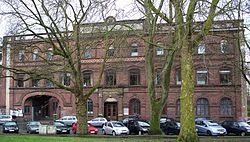Bochum ironworks Heintzmann
The Bochumer Eisenhütte Heintzmann GmbH & Co. KG is a company in Bochum with a focus on mining, tunneling and heat treatment.
history
The company was founded as an iron foundry on May 17, 1851 by the lawyer Egmont Heintzmann (born April 29, 1806, † June 24, 1874) together with the banker Carl Korte and the judge Moritz Bölling. It was in the early days the name Korte & Co . The company soon made a name for itself as a supplier of machines and other accessories for the mining industry. In 1867 there were already 90 employees.
When the banker Korte left the company in 1874, the engineer Albert Dreyer, who had been with the company since 1860, took part; the company was called Bochumer Eisenhütte Heintzmann und Dreyer. In 1890, among other things, steam pumps, coke extraction machines and insulating doors were manufactured. In 1899 they moved into the administration building on what was then Blücherstraße (today Stühmeyerstraße), which still bears witness to the industrial site in Bochum's city center - the administration building of the neighboring Fahrendeller Hütte, which was taken over in 1919, still exists today.
After the First World War , the company already employed 500 workers and changed its name to Bochumer Eisenhütte Heintzmann & Co., GmbH . Heinrich Toussaint from Berlin developed the TH profile together with Egmont Heintzmann in 1930 , which represented a leap in development in steel construction in mining and tunnel construction due to its defined flexibility. The plant on Blücherstraße was completely destroyed in 1944, but due to expansion after the war, the factory in Klosterstraße was moved into in 1954 and in 1974 the plant on Bessemerstraße (formerly part of the "steel industry" of the Bochumer Verein and later the Deutsche Edelstahlwerke AG ). Further developments include further profiles and assembly accessories, shields , stamps and supports for mining.
today
Over the years, other companies have been acquired or established. Today, the Heintzmann Group operates internationally, but has moved away from mechanical engineering and mainly offers construction materials and related services. The subsidiary Saarland Society for Mine Expansion and Technology , which was founded in 1949 to supply the Lorraine and Saarland mines , is now engaged in e.g. B. with the production of guard rails .
Since March 2014 the company has also been listed in the Route of Industrial Culture , themed route Bochum .
literature
- Gustav Hempel: 100 years of the Bochum ironworks Heintzmann. , Bochum: Kamps, 1951
- Kurt Heinz Voss: One hundred and forty years of the Heintzmann ironworks in Bochum. In: Glückauf. Volume 127 (1991), pp. 998-1004
- Economic mirror of German cities - Bochum - production and economic area, W. Giradet graphic companies and publishing house, Essen 1952, without page numbers
Individual evidence
- ↑ Data from the tombstone of the family crypt at the Bochum flower cemetery
- ↑ Section 100 Years of Bochum Ironworks (1851 - 1951) in the New Home Books section on www.bochum.de
- ↑ History of shotcrete construction, Part II - Milestones in the development up to 1960 ( Memento of the original from September 27, 2009 in the Internet Archive ) Info: The archive link was inserted automatically and has not yet been checked. Please check the original and archive link according to the instructions and then remove this notice. (PDF; 441 kB), K. Kovári, ETH Zurich in Tunnel 2/2002
Web links
- http://www.be-heico.de
- New home literature from the area of the old Bochum office since 1951
- Louise Heintzmann
- Description of this sight on the route of industrial culture
Coordinates: 51 ° 28 ′ 26.9 " N , 7 ° 12 ′ 26.3" E





